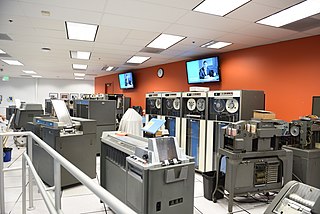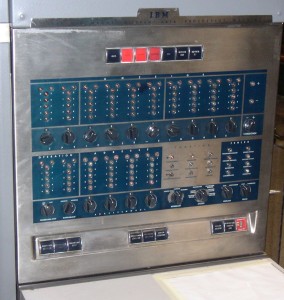
In computer programming, assembly language, often referred to simply as assembly and commonly abbreviated as ASM or asm, is any low-level programming language with a very strong correspondence between the instructions in the language and the architecture's machine code instructions. Assembly language usually has one statement per machine instruction (1:1), but constants, comments, assembler directives, symbolic labels of, e.g., memory locations, registers, and macros are generally also supported.
The byte is a unit of digital information that most commonly consists of eight bits. Historically, the byte was the number of bits used to encode a single character of text in a computer and for this reason it is the smallest addressable unit of memory in many computer architectures. To disambiguate arbitrarily sized bytes from the common 8-bit definition, network protocol documents such as the Internet Protocol refer to an 8-bit byte as an octet. Those bits in an octet are usually counted with numbering from 0 to 7 or 7 to 0 depending on the bit endianness.

In computing and electronic systems, binary-coded decimal (BCD) is a class of binary encodings of decimal numbers where each digit is represented by a fixed number of bits, usually four or eight. Sometimes, special bit patterns are used for a sign or other indications.
Extended Binary Coded Decimal Interchange Code is an eight-bit character encoding used mainly on IBM mainframe and IBM midrange computer operating systems. It descended from the code used with punched cards and the corresponding six-bit binary-coded decimal code used with most of IBM's computer peripherals of the late 1950s and early 1960s. It is supported by various non-IBM platforms, such as Fujitsu-Siemens' BS2000/OSD, OS-IV, MSP, and MSP-EX, the SDS Sigma series, Unisys VS/9, Unisys MCP and ICL VME.
In mathematics and computing, the hexadecimal numeral system is a positional numeral system that represents numbers using a radix (base) of sixteen. Unlike the decimal system representing numbers using ten symbols, hexadecimal uses sixteen distinct symbols, most often the symbols "0"–"9" to represent values 0 to 9, and "A"–"F" to represent values from ten to fifteen.

The IBM 1401 is a variable-wordlength decimal computer that was announced by IBM on October 5, 1959. The first member of the highly successful IBM 1400 series, it was aimed at replacing unit record equipment for processing data stored on punched cards and at providing peripheral services for larger computers. The 1401 is considered to be the Ford Model-T of the computer industry, because it was mass-produced and because of its sales volume. Over 12,000 units were produced and many were leased or resold after they were replaced with newer technology. The 1401 was withdrawn on February 8, 1971.
In computing, a code page is a character encoding and as such it is a specific association of a set of printable characters and control characters with unique numbers. Typically each number represents the binary value in a single byte.

The IBM 709 was a computer system, initially announced by IBM in January 1957 and first installed during August 1958. The 709 was an improved version of its predecessor, the IBM 704, and was the third of the IBM 700/7000 series of scientific computers. The improvements included overlapped input/output, indirect addressing, and three "convert" instructions which provided support for decimal arithmetic, leading zero suppression, and several other operations. The 709 had 32,768 words of 36-bit magnetic core memory and could execute 42,000 add or subtract instructions per second. It could multiply two 36-bit integers at a rate of 5000 per second.

The IBM 700/7000 series is a series of large-scale (mainframe) computer systems that were made by IBM through the 1950s and early 1960s. The series includes several different, incompatible processor architectures. The 700s use vacuum-tube logic and were made obsolete by the introduction of the transistorized 7000s. The 7000s, in turn, were eventually replaced with System/360, which was announced in 1964. However the 360/65, the first 360 powerful enough to replace 7000s, did not become available until November 1965. Early problems with OS/360 and the high cost of converting software kept many 7000s in service for years afterward.

In computer architecture, 36-bit integers, memory addresses, or other data units are those that are 36 bits wide. Also, 36-bit central processing unit (CPU) and arithmetic logic unit (ALU) architectures are those that are based on registers, address buses, or data buses of that size. 36-bit computers were popular in the early mainframe computer era from the 1950s through the early 1970s.
Chen–Ho encoding is a memory-efficient alternate system of binary encoding for decimal digits.
RADIX 50 or RAD50, is an uppercase-only character encoding created by Digital Equipment Corporation (DEC) for use on their DECsystem, PDP, and VAX computers.
Several 8-bit character sets (encodings) were designed for binary representation of common Western European languages, which use the Latin alphabet, a few additional letters and ones with precomposed diacritics, some punctuation, and various symbols. These character sets also happen to support many other languages such as Malay, Swahili, and Classical Latin.

The IBM 2741 is a printing computer terminal that was introduced in 1965. Compared to the teletypewriter machines that were commonly used as printing terminals at the time, the 2741 offers 50% higher speed, much higher quality printing, quieter operation, interchangeable type fonts, and both upper and lower case letters.
Densely packed decimal (DPD) is an efficient method for binary encoding decimal digits.
A six-bit character code is a character encoding designed for use on computers with word lengths a multiple of 6. Six bits can only encode 64 distinct characters, so these codes generally include only the upper-case letters, the numerals, some punctuation characters, and sometimes control characters. The 7-track magnetic tape format was developed to store data in such codes, along with an additional parity bit.

Decimal computers are computers which can represent numbers and addresses in decimal as well as providing instructions to operate on those numbers and addresses directly in decimal, without conversion to a pure binary representation. Some also had a variable wordlength, which enabled operations on numbers with a large number of digits.
The SHARE Operating System (SOS) is an operating system introduced in 1959 by the SHARE user group. It is an improvement on the General Motors GM-NAA I/O operating system, the first operating system for the IBM 704. The main objective was to improve the sharing of programs.
In computer architecture, 18-bit integers, memory addresses, or other data units are those that are 18 bits wide. Also, 18-bit central processing unit (CPU) and arithmetic logic unit (ALU) architectures are those that are based on registers, address buses, or data buses of that size.
BCD, also called alphanumeric BCD, alphameric BCD, BCD Interchange Code, or BCDIC, is a family of representations of numerals, uppercase Latin letters, and some special and control characters as six-bit character codes.








